成為孔子旅游使者,感受山東非遺魅力
Be the Confucius Tourism Envoys for the Glamorous Intangible Cultural Heritage of Shandong Province
文化是自然造化與人類(lèi)智慧的完美結(jié)晶,非物質(zhì)文化遺產(chǎn)是人類(lèi)世代相承、與生產(chǎn)生活密切相關(guān)的各種傳統(tǒng)文化的表現(xiàn)形式。
Culture is a perfect crystallization of the nature’s power and human wisdom, while intangible cultural heritage is a manifestation of various traditional cultures that are inherited from generation to generation and closely related to production and life.
中國(guó)山東省是非物質(zhì)文化遺產(chǎn)大省,非物質(zhì)文化遺產(chǎn)數(shù)量龐大,種類(lèi)繁多。截止2020年4月,中國(guó)山東省共有聯(lián)合國(guó)教科文組織認(rèn)定的“人類(lèi)非遺代表作名錄”項(xiàng)目8個(gè),國(guó)家級(jí)非遺名錄173項(xiàng),省級(jí)非遺名錄751項(xiàng),市級(jí)非遺名錄3700多項(xiàng);現(xiàn)有國(guó)家級(jí)非遺傳承人90多名,省級(jí)非遺傳承人440多名,市級(jí)非遺傳承人2200多名;國(guó)家級(jí)文化生態(tài)保護(hù)區(qū)1個(gè),省級(jí)文化生態(tài)保護(hù)實(shí)驗(yàn)區(qū)10個(gè)。
Shandong Province of China is home to a large number and rich variety of intangible cultural heritage. As of April 2020, Shandong had eight items inscribed on the UNESCO’s Representative List of the Intangible Cultural Heritage of Humanity, over 170 on the national list, some 751 on the provincial-level list, and 3700-plus on the municipal-level list. Moreover, the province boasts 90-plus representative inheritors of intangible cultural heritage at the national level, over 440 at the provincial level and more than 2,200 at the municipal level. In addition, there is one national-level eco-cultural preservation area and ten provincial-level experimental zones for eco-cultural preservation in the province.
祭孔大典
Confucius Memorial Ceremony
祭孔大典是山東省曲阜專(zhuān)門(mén)祭祀孔子的大型廟堂樂(lè)舞活動(dòng),是集樂(lè)、歌、舞、禮為一體的綜合性藝術(shù)表演形式,形象地闡釋了孔子學(xué)說(shuō)中“仁”“禮”的涵義,體現(xiàn)了藝術(shù)形式與思想內(nèi)容的高度統(tǒng)一,集中表現(xiàn)了儒家文化,于每年陰歷八月二十七日孔子誕辰時(shí)舉行。2006年列入《第一批國(guó)家級(jí)非物質(zhì)文化遺產(chǎn)名錄》。
The Confucius Memorial Ceremony is a large-scale performance involving music and dance at a temple to worship Confucius in Qufu of Shandong Province, the hometown of Confucius. It’s a comprehensive art performance that integrates music, singing, dancing, and rites. It vividly interprets the meaning of the concepts of “Ren” (benevolence) and “Li” (propriety) in Confucianism, represents the high degree of unity of artistic form and ideological content, and epitomizes the Confucian culture. It is held every year on August 27th of the lunar calendar, the birth date of Confucius. In 2006, it was inscribed on the First Representative List of State-Level Intangible Cultural Heritage in China.

呂劇
Lv Opera
呂劇起源于山東北部黃河三角洲的東營(yíng)市,流行于山東以及江蘇、安徽的部分地區(qū),是山東省的代表性劇種。呂劇由民間說(shuō)唱藝術(shù)“山東琴書(shū)”發(fā)展演變而來(lái),主要樂(lè)器是墜琴、揚(yáng)琴、三弦、琵琶等“呂劇四大件”。呂劇的創(chuàng)作源于生活,具有濃郁的鄉(xiāng)土氣息。2008年列入《第二批國(guó)家級(jí)非物質(zhì)文化遺產(chǎn)名錄》。山東省呂劇藝術(shù)保護(hù)傳承中心(山東省呂劇院)的代表劇目《姊妹易嫁》《苦菜花》《大河開(kāi)凌》等廣受好評(píng),享譽(yù)全國(guó)。
Lv Opera originated in Dongying City in the Yellow River Delta in northern Shandong Province and became popular in the entire province of Shandong and in parts of Jiangsu and Anhui provinces. As the most representative local opera in Shandong, Lv Opera had evolved from the Shandong Qinshu, a traditional narrative music which emphasizes a conversational style of singing. The main instruments used in Lv Opera are the zhuiqin (a stringed instrument), dulcimer, sanxian (a three-stringed plucked instrument), and pipa (a 4-stringed Chinese lute), dubbed “the four major pieces for “Lv Opera”. The creation of Lv Opera is based on real life with a rich local flavor. It was included in the Second Representative List of State-Level Intangible Cultural Heritage in China in 2008. The representative plays of Shandong Lv Opera Art Preservation and Inheritance Center (Shandong Lv Opera Theater), such as Sisters Switch Places, Ku Cai Hua (literally bitter vegetable flower), and River Kailing, have been widely acclaimed and popular throughout the country
呂劇《雙生花》
Lv Opera “Twin Flower”
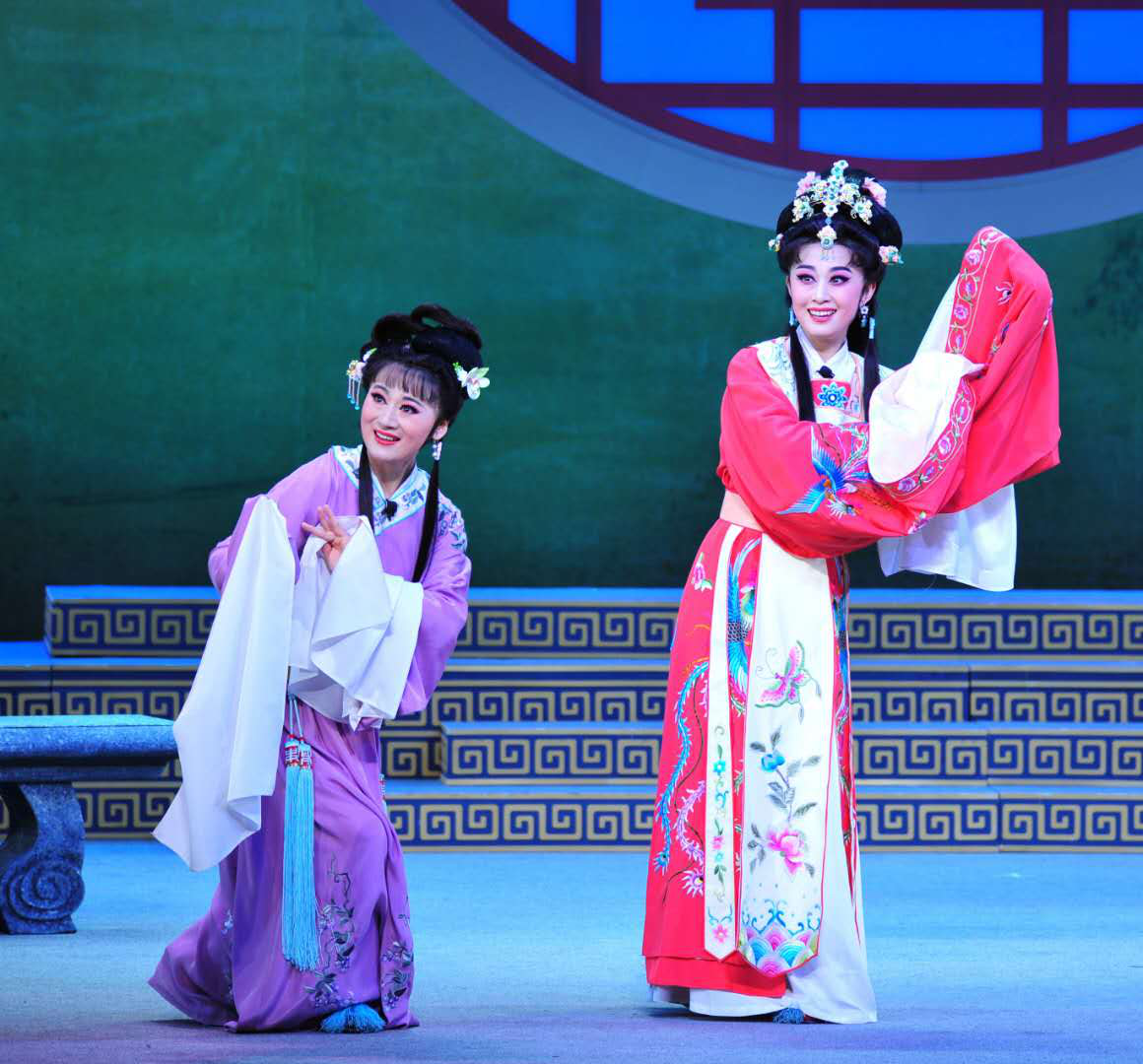
柳子戲
Liuzi Opera
柳子戲又名弦子戲,是中國(guó)戲曲古老聲腔之一,流行于魯蘇豫皖冀五省交界地,因曲牌中有一種柳子調(diào),故得名柳子戲。該戲與大弦子戲、羅子戲等同出一源且相互影響,都以三弦作為主要樂(lè)器,輔之笙、笛。其中濟(jì)寧汶上一帶柳子戲又吸收“汶上梆子”配樂(lè)和唱法,使柳子戲唱腔更加豐富。2006年列入《第一批國(guó)家級(jí)非物質(zhì)文化遺產(chǎn)名錄》。山東省柳子戲藝術(shù)保護(hù)傳承中心(山東省柳子劇團(tuán))是全國(guó)唯一的柳子戲藝術(shù)表演團(tuán)體。
Liuzi Opera, also known as “Xianzi Opera”, is an ancient genre of Chinese opera popular at the junction areas of five provinces, namely Shandong, Jiangsu, Henan, Anhui, and Hebei. It’s named after the representative tune of “Liuzi”. Sharing the same origin with Daxianzi Opera and Luozi Opera, Liuzi Opera is usually performed with the three-stringed instruments that are accompanied by a flute and a sheng (a woodwind instrument). The Liuzi Opera in Wenshang County in Jining City of Shandong Province absorbed the elements of music and tune of “Wenshang Bangzi” (Wooden Clapper Opera) that enriched the tunes of Liuzi Opera. In 2006, it was included in the First Representative List of State-Level Intangible Cultural Heritage in China. The representative plays of Shandong Liuzi Opera Art Preservation and Inheritance Center (Shandong Liuzi Opera Troupe) is the only performing art group of Liuzi Opera plays in China.
柳子戲《張飛闖轅門(mén)》
Liuzi Opera “Zhang Fei Breaking into the Military Gate”
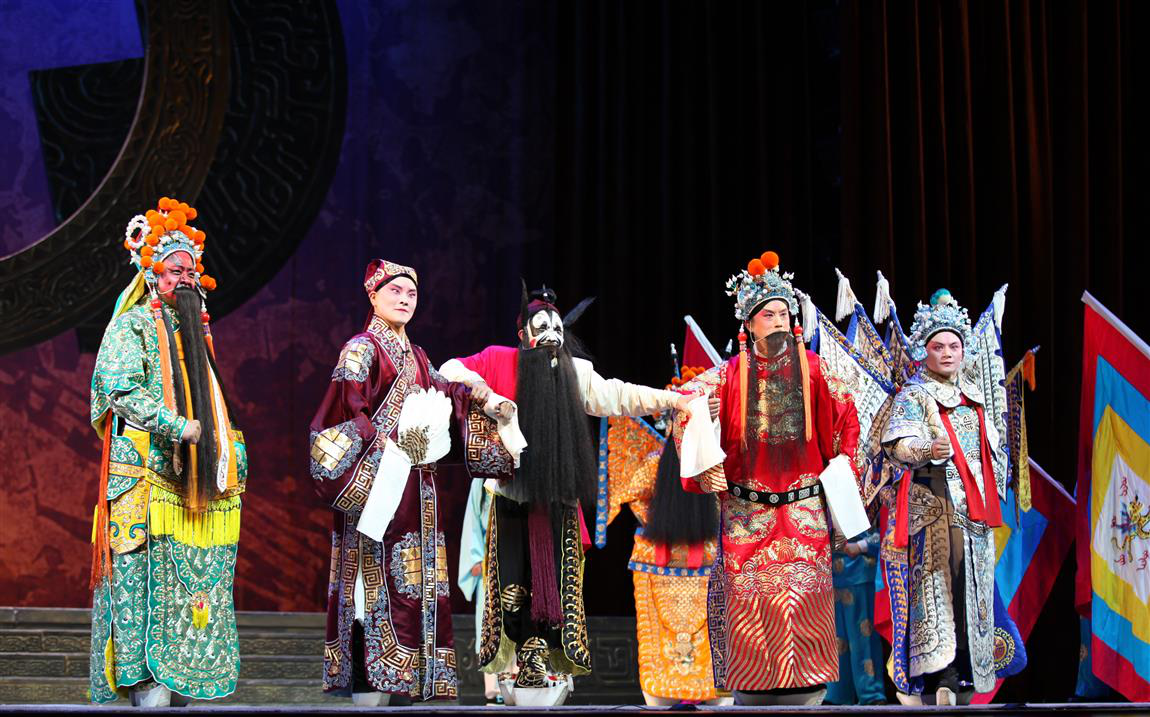
楊家埠木版年畫(huà)
The Yangjiabu Woodcut New Year Paintings
濰坊楊家埠木版年畫(huà)是流傳于山東省濰坊市楊家埠的一種民間版畫(huà),興于明初,盛于清嘉慶年間,迄今已有600多年的歷史,與天津楊柳青、蘇州桃花塢并稱(chēng)為“中國(guó)三大木版年畫(huà)”。它鄉(xiāng)土氣息濃郁,藝術(shù)風(fēng)格淳樸鮮明,是中國(guó)民間藝術(shù)寶庫(kù)中的瑰寶。2006年5月,被國(guó)務(wù)院公布為第一批國(guó)家級(jí)非物質(zhì)文化遺產(chǎn)代表性項(xiàng)目。
The Yangjiabu Woodcut New Year Paintings in Weifang is a type of folk woodblock prints popular in Yangjiabu of Weifang City in Shandong Province. It emerged in the early Ming Dynasty (1368-1644) and flourished during the reign of Emperor Jiaqing (1796–1820) in the Qing Dynasty. Along with the New Year Paintings produced in Yangliuqing of Tianjian and in Taohuawu of Suzhou, they constituted the “three major woodcut New Year paintings of China”. By virtue of its rich rustic flavor and distinctive artistic style, it has been a treasure of Chinese folk art. In May 2006, it was inscribed on the list of the First Representative List of State-Level Intangible Cultural Heritage in China released by the State Council.

德州黑陶燒制技藝
Dezhou Black Pottery Craft
德州黑陶是中國(guó)黑陶的一種,其歷史淵源可追溯到距今已有四千多年的新石器時(shí)代龍山文化。龍山文化時(shí)代的中國(guó)先民崇拜黑色,黑陶中的蛋殼陶為當(dāng)時(shí)最高規(guī)制的祭祀用禮器。德州黑陶是一種無(wú)釉陶器,采用京杭運(yùn)河兩岸的紅膠泥作原料,用傳統(tǒng)的手工輪制成型,留存著大汶口文化陶器的傳統(tǒng)軌跡。2014年列入第四批國(guó)家級(jí)非物質(zhì)文化遺產(chǎn)代表性項(xiàng)目名錄擴(kuò)展項(xiàng)目名錄。
Dezhou Black Pottery, as a category of Chinese black pottery, could trace its history back to the Longshan Culture during the Neolithic Age over 4,000 years ago. Back then, Chinese ancestors worshiped the black color and the black egg-shell pottery was used as the supreme sacrificial vessel. Dezhou Black Pottery is a non-glazed pottery that is made from the red clay of Beijing-Hangzhou Canal and shaped by traditional handcraft, carrying the traditional remains of the pottery in the Dawenkou Culture. In 2014, Dezhou black pottery craft was included in the Fourth Extended Representative List of State-level Intangible Cultural Heritage.
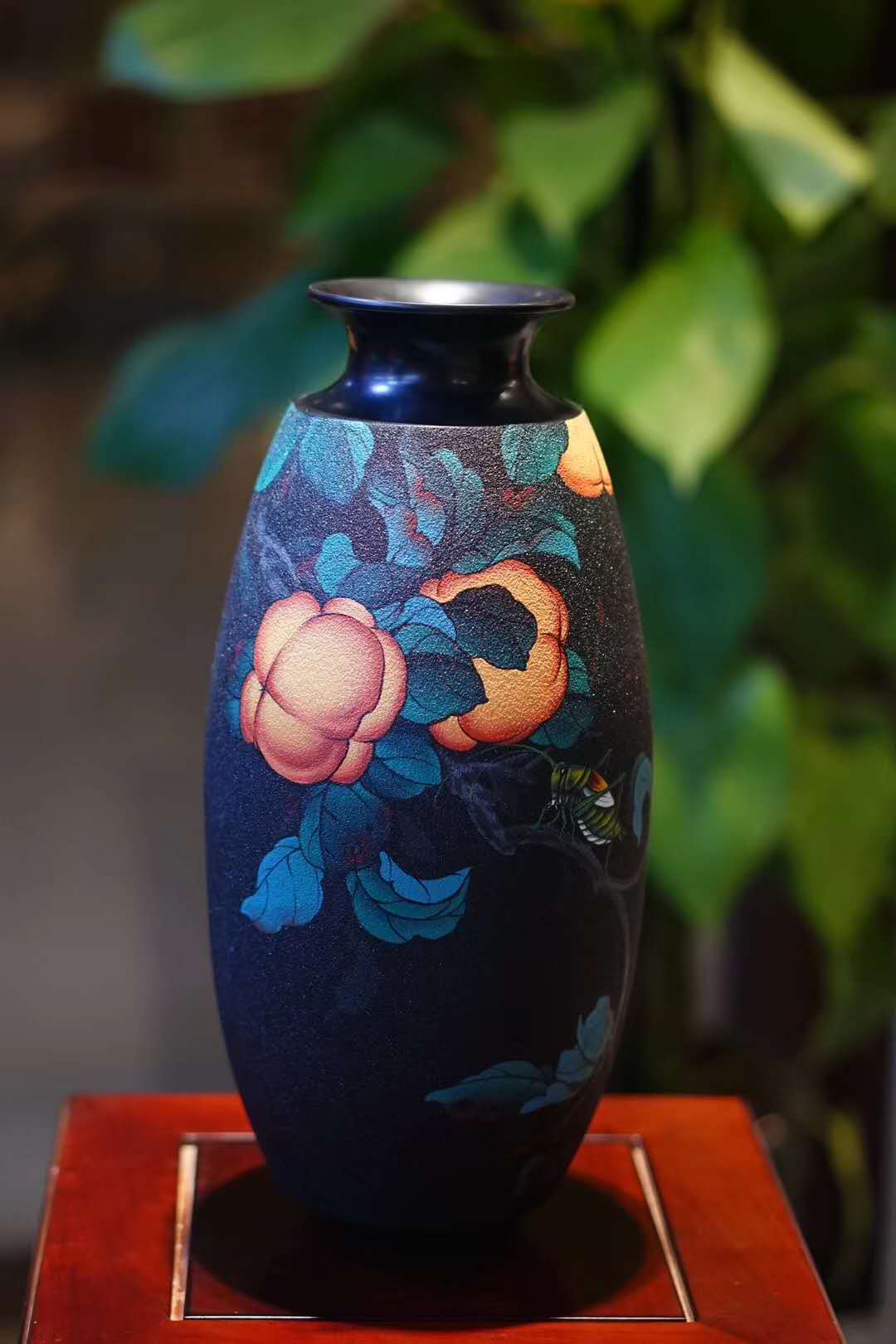
海陽(yáng)大秧歌
Haiyang Yangge (folk dance)
海陽(yáng)大秧歌是山東三大秧歌之一,集歌、舞、戲于一體的民間藝術(shù)形式。海陽(yáng)大秧歌素以粗獷奔放、感情充沛、風(fēng)趣幽默的表演風(fēng)格著稱(chēng)于世,表演內(nèi)容豐富,舞蹈動(dòng)作跑扭結(jié)合,隊(duì)伍結(jié)構(gòu)主要由執(zhí)事、樂(lè)隊(duì)、秧歌劇人物或戲曲雜扮者三部分組成。海陽(yáng)大秧歌是海陽(yáng)地域文化的重要組成部分。
Haiyang Yangge (folk dance), one of the three Yangge forms in Shandong Province, is a folk art form that integrates music, dance and opera. Haiyang Yangge has been well-known as straightforward, unrestrained, emotional and humorous. It is performed in constantly changing forms and contents. The performance group is mainly composed of a leader, a music band and a character in the play or an opera player. It’s an integral part of the local culture in Haiyang.

廣饒齊筆制作技藝
Qi Writing Brush in Guangrao
齊筆主要分布在山東省廣饒縣,制作技藝起源于春秋戰(zhàn)國(guó)時(shí)期。齊筆從選料到成筆,要經(jīng)過(guò)浸、拔、梳、剔等150多道工序,具有尖、齊、圓、健四德。齊筆的成品筆鋒要達(dá)到毫尖平齊,腰部剛挺有彈性;書(shū)寫(xiě)時(shí)則要?jiǎng)側(cè)嵯酀?jì),鋒毫聚而不散。中國(guó)書(shū)畫(huà)界盛譽(yù)齊筆“鋒穎尖銳、豐碩圓滿(mǎn)、修削整齊、健勁有力”。
Qi writing brush is mainly made in Guangrao County of Shandong Province and the craft of making the Qi writing brush originated in the Spring and Autumn Period (770–476 BC) and the Warring States Period (475–221 BC). The process of making the brush, ranging from the selection of material to the finished product, involves 150-plus steps, such as dipping, pulling, combing, and picking. Qi writing brush distinguished itself with four virtues of being “pointy, even, round, and resilient”. The brush tip should be as pointed as an awl and the brush waist or spine should be solid and resilient. While writing, it can be both solid and soft, with the hair on the brush always forming a defined and symmetrical tip. Qi writing brush has a reputation among Chinese painters and calligraphers for being “pointy, round, plump, neatly trimmed, resilient and solid”.
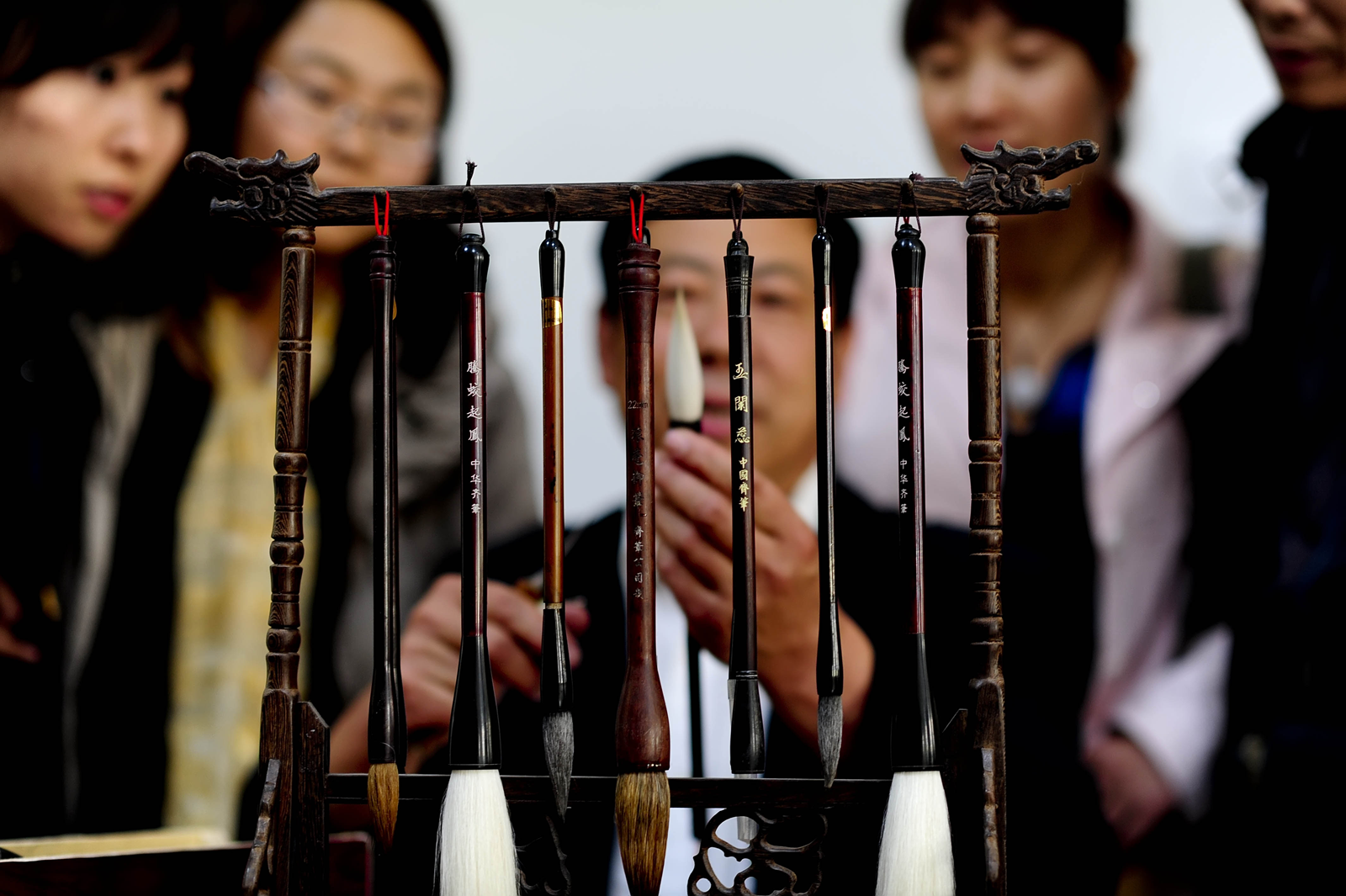
東昌葫蘆雕刻
Dongchang Gourd Carving
東昌葫蘆雕刻藝術(shù)風(fēng)格淳樸典雅,題材廣泛,技法獨(dú)特,風(fēng)格多樣。東昌葫蘆雕刻的內(nèi)容主要涉及神話(huà)、民俗,其寓意與仙道、富貴、長(zhǎng)壽、子孫繁盛等有密切相關(guān),文化內(nèi)涵豐富,是中國(guó)葫蘆文化的重要組成部分。2008年6月,東昌葫蘆雕刻被列入第二批國(guó)家級(jí)非物質(zhì)文化遺產(chǎn)名錄。
Dongchang gourd carving art features a simple and elegant style, a wide range of themes, unique techniques, as well as rich varieties. The content of the Dongchang gourd carving art mainly involves myths and folk customs, carrying implications that are closely related to immortals, wealth, longevity, and prosperity of descendants. Having been invested with cultural significance, it is an integral part of Chinese gourd culture. In June 2008, it was inscribed on the Second Representative List of State-Level Intangible Cultural Heritage in China.
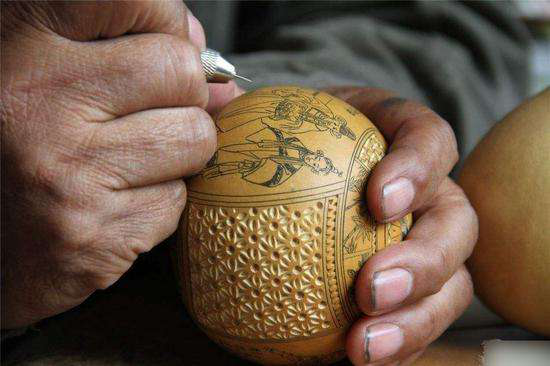
高密剪紙
Gaomi Paper-cut
高密剪紙包括窗花、門(mén)箋、墻花、頂棚花等,它的流傳同山東高密農(nóng)村的節(jié)令風(fēng)俗有著密切的關(guān)系。高密剪紙題材廣泛內(nèi)容豐富,花草蟲(chóng)魚(yú)、飛禽走獸和人物皆可入剪。根據(jù)寓意可以分為納吉、祝福、祛邪、除惡、勸勉、警戒等七類(lèi),紋樣可以分為人物、鳥(niǎo)獸、文字等十幾類(lèi),題材多取自民間傳說(shuō)、神話(huà)和戲曲故事。高密剪紙象征性強(qiáng),造型樸實(shí)夸張,粗獷中見(jiàn)清秀,拙樸中藏精巧。
Gaomi paper-cuts could be seen to adorn windows, doors, walls and ceilings. The boom of the art has been closely associated with the festive customs in rural areas of Gaomi in Shandong Province. The paper could be cut into endless patterns, ranging from flowers, grass, insects, fish, birds, beasts to images of people. In terms of its uses, the paper cutting falls into seven categories for presenting betrothal gifts, giving blessings, dispelling bad omens, eliminating evils, encouragement, and caution. The patterns could be divided into a dozen of categories, such as images of people, birds and beasts, characters, and so on. The contents are largely based on folk legends, myths and opera plays. Gaomi paper-cut is symbolic of Chinese paper cutting, with simple and exaggerated design that is straightforward yet elegant, concise yet elaborate.
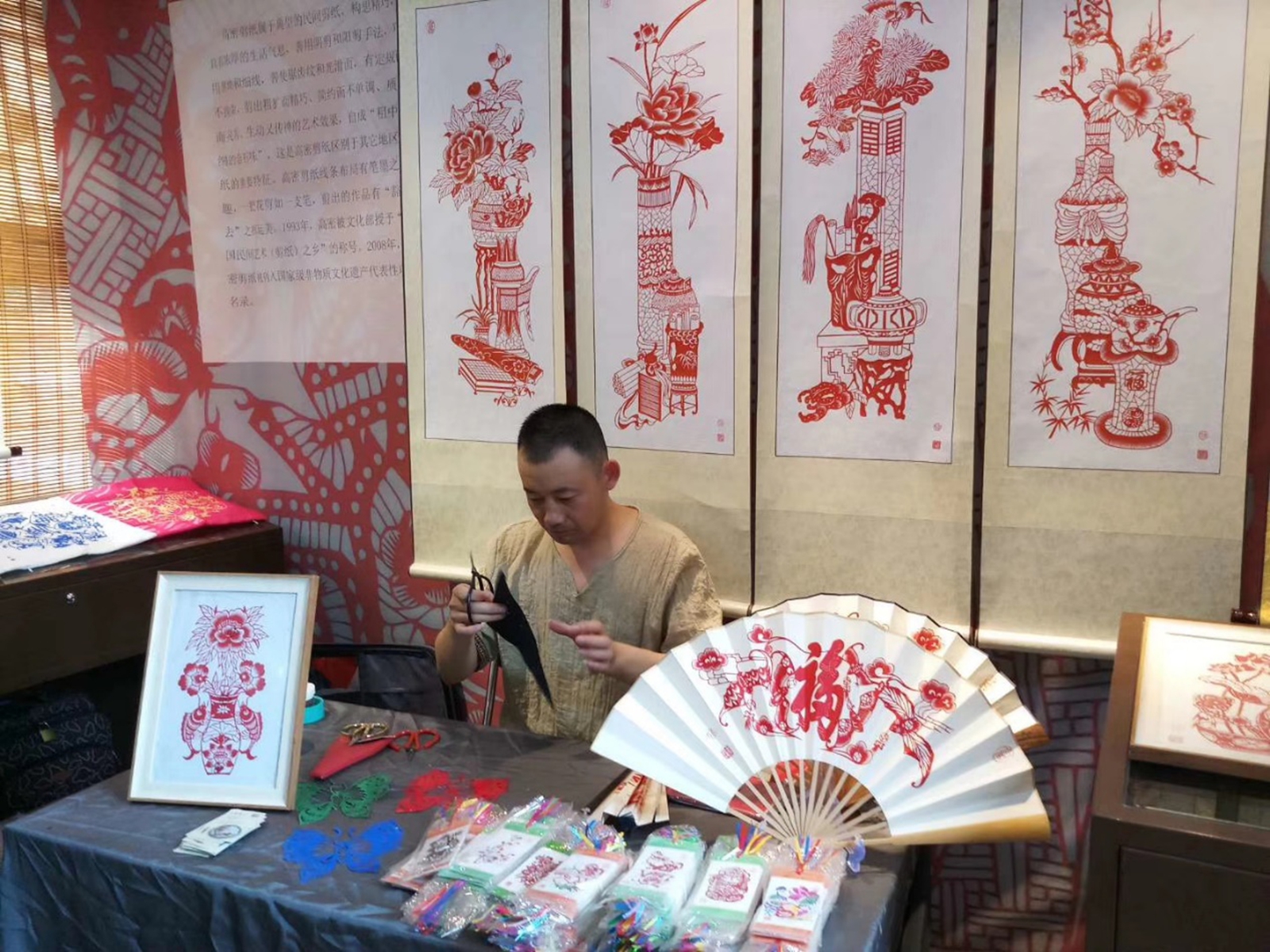
東明糧畫(huà)
Dongming Grain Painting
東明糧畫(huà)制作技藝,又名“福籽繪”,主要是巧妙利用五谷雜糧的天然形狀和顏色,經(jīng)過(guò)防腐防蟲(chóng)處理后,拼粘而成的傳統(tǒng)民間工藝畫(huà),具有“五谷豐登、國(guó)泰民安”的美好寓意,色彩豐富、做工精細(xì)、構(gòu)思巧妙,被人們稱(chēng)為掛在墻上的“精神食糧”。
Dongming grain painting, also known as “Fu-zi painting”, is a traditional folk craft. It mainly uses the natural colors and shapes of cereal grains after anti-corrosion and insect-proof treatment to artfully paste various auspicious patterns on wooden boards or porcelain plates to pray for a good grain harvest, prosperity for the nation and peace for the people. Such paintings are characterized by bright colors, elaborate skills and indigenous designs, which has won it the reputation of “spiritual food” hanging on the wall.
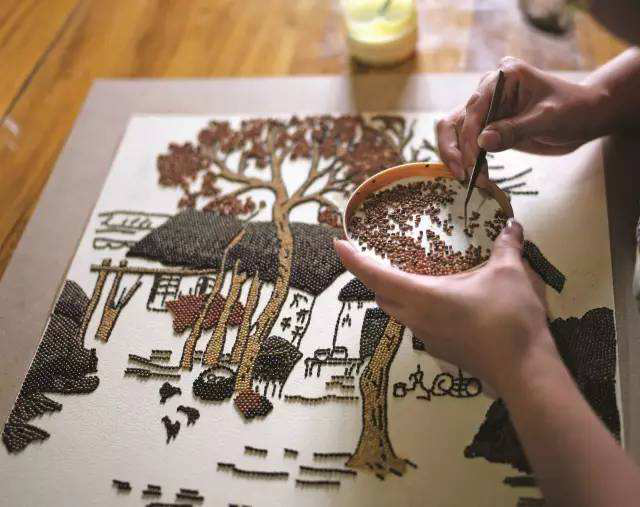
侯氏社火臉譜
Shehuo Facial Makeup of Hou Family
社火”亦稱(chēng)“射虎”,指古代民間祭祀或節(jié)日里迎神賽會(huì)上的各種表演。社火臉譜指人們?cè)谏缁鸹顒?dòng)中,為準(zhǔn)確扮演社火人物形象,而在面部進(jìn)行的彩繪及修飾等。社火臉譜亦可脫離社火表演獨(dú)立存在。侯氏社火臉譜根據(jù)社火文化的發(fā)展與當(dāng)時(shí)社會(huì)歷史背景,繪制出百姓喜聞樂(lè)見(jiàn)的“舜帝”“姜太公”等臉譜。
Shehuo, also known as “she-hu (tiger shooting)”, is a kind of folk performance originated from the sacrificial ceremonies in ancient times or the folk festival that involves shrine or image of God. Shehuo facial makeup refers to the face paintings or make-ups for the performers to make them look more like the roles they played. Shehuo facial makeup can exist independently from Shehuo performance. The Hou Family is renowned for making the facial makeup of Emperor Shun, Jiang Taigong and other images that are popular among the people, in line with the development of Shehuo culture and the actual social and historical context.
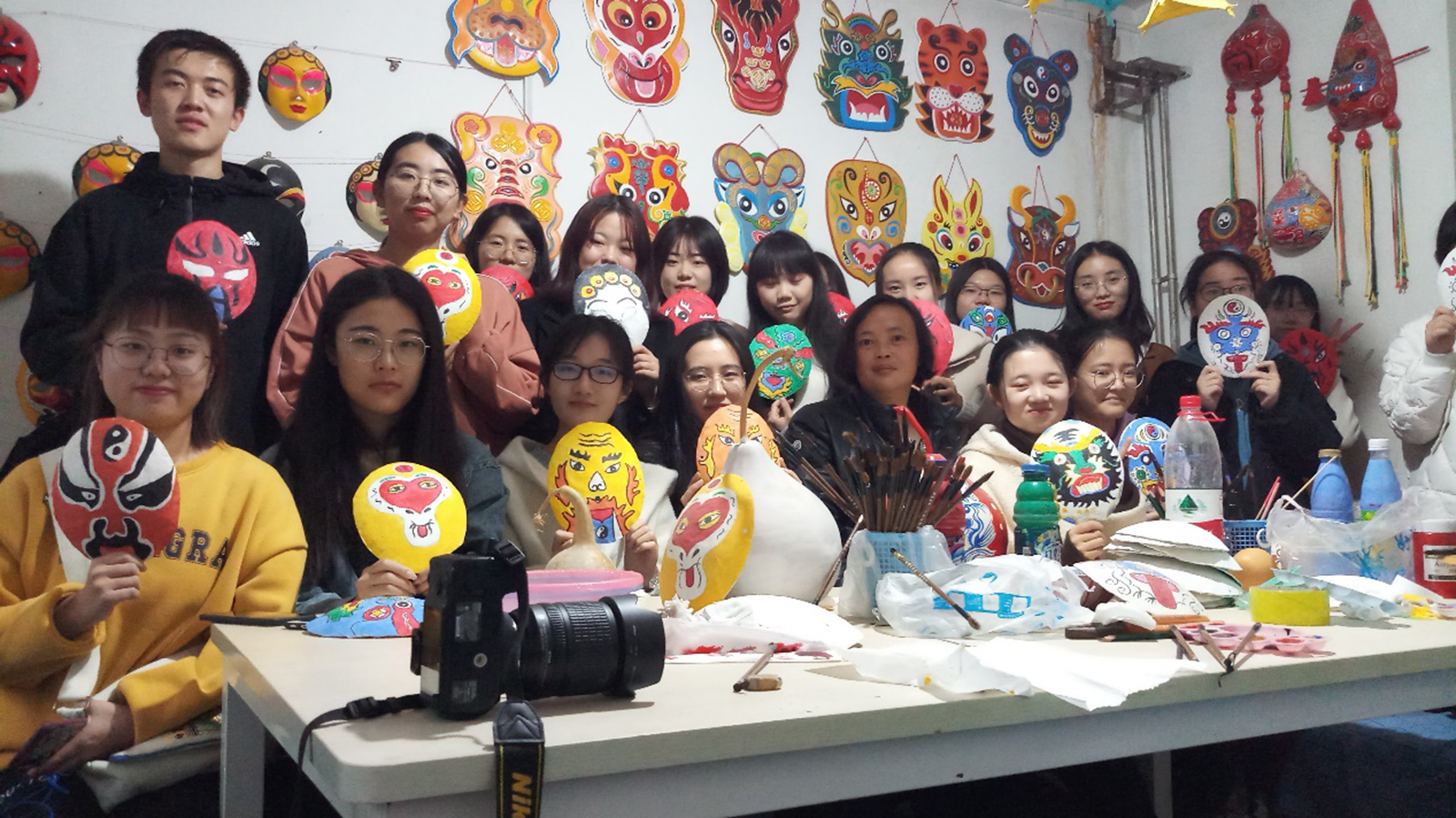
高密撲灰年畫(huà)
Gaomi Ash-patting New Year Painting
高密撲灰年畫(huà)亦稱(chēng)“民間寫(xiě)意畫(huà)”,作畫(huà)時(shí)先用柳枝燒制的炭條打好草稿,然后用毛筆勾描,再用白紙拓印,一稿可拓?fù)涠鄰垼皳浠摇庇纱说妹浠液蟮漠?huà)稿還要加以手繪,經(jīng)多道工序后才能成畫(huà)。高密撲灰年畫(huà)在發(fā)展過(guò)程中善于吸收各種繪畫(huà)因素和造型風(fēng)格,保存了中國(guó)民間繪畫(huà)的傳統(tǒng)技能。
Gaomi ash-patting New Year Painting is also known as “folk freehand brush work”. To make such a painting, a rubbing is made from a first draft drawn in charred sallow and delineated by a brush. Next the draft is rubbed on drawing paper, if needed, a rubbing can produce several copies of the drawings. Afterwards the drawing is hand painted and subjected to several other procedures. Over the years, Gaomi ash-patting New Year painting has absorbed various elements and styles from other types of paintings, while preserving the traditional techniques of Chinese folk paintings.
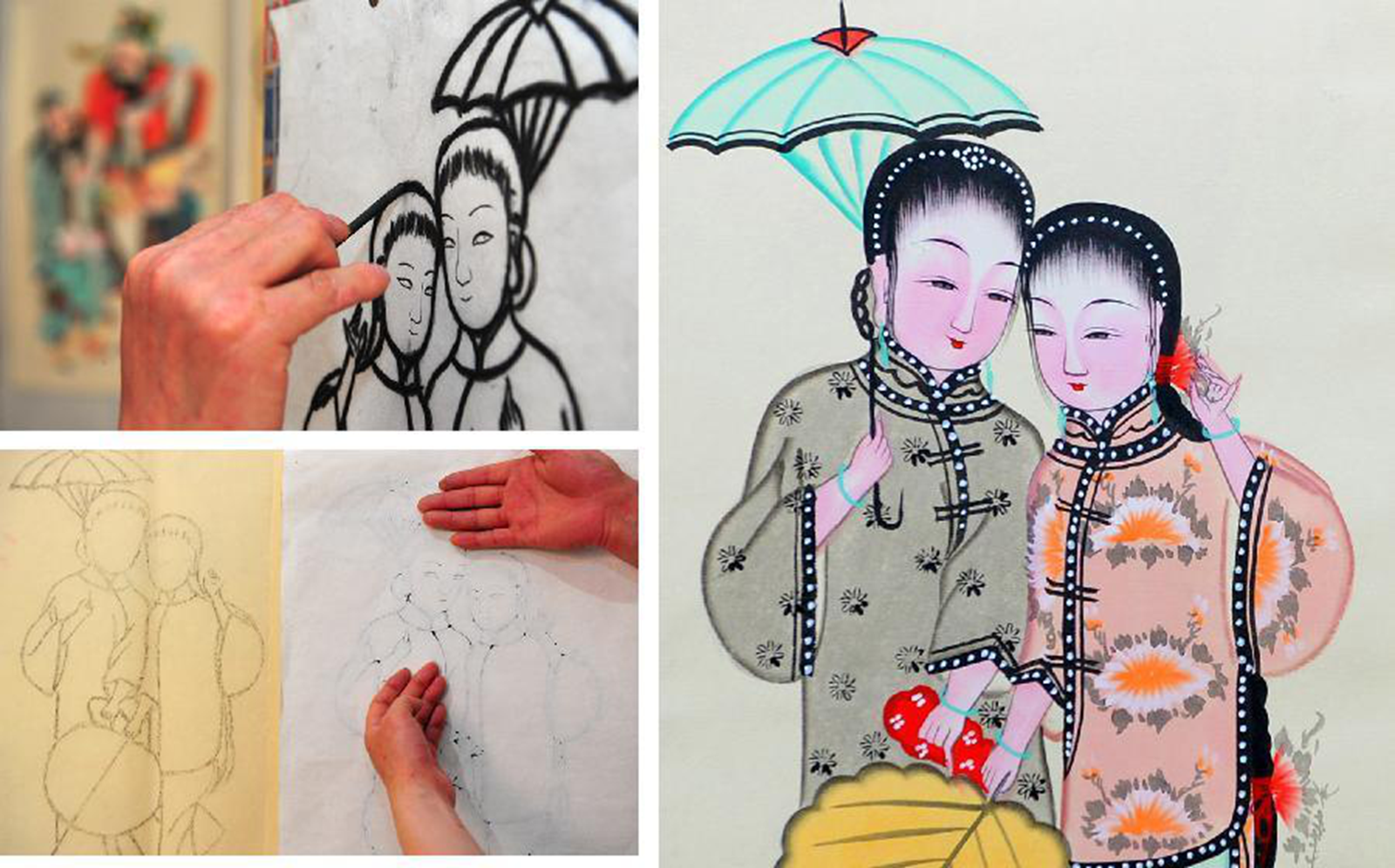
濟(jì)南結(jié)藝
Chinese Knotting Art in Ji’nan
中國(guó)結(jié)藝是中國(guó)民間手工編結(jié)藝術(shù)。濟(jì)南結(jié)藝的編制,大致分為基本結(jié)、變化結(jié)及組合結(jié)三大類(lèi),其編結(jié)技術(shù),除了需熟練各種基本結(jié)的編結(jié)技巧外,均具共通的編結(jié)原理,并可歸納為基本技法與組合技法。設(shè)計(jì)一組美觀(guān)大方的結(jié)飾,把自己的藝術(shù)美感和濃濃情思融注其中,便能充分表現(xiàn)出中國(guó)傳統(tǒng)藝術(shù)之美。
Chinese knot is a folk hand-knotting art in China. The Chinese knots in Ji’nan can be roughly divided into three categories—the knot in basic patterns, varied patterns and combined patterns. Apart from the elementary knotting skills for basic patterns, there are some commonly-used techniques that can be summarized as basic techniques and combined techniques. To design beautiful and elegant knots for decoration, you also need to inject your own artistic ideas and strong feelings into it, so as to fully display the beauty of traditional Chinese art.
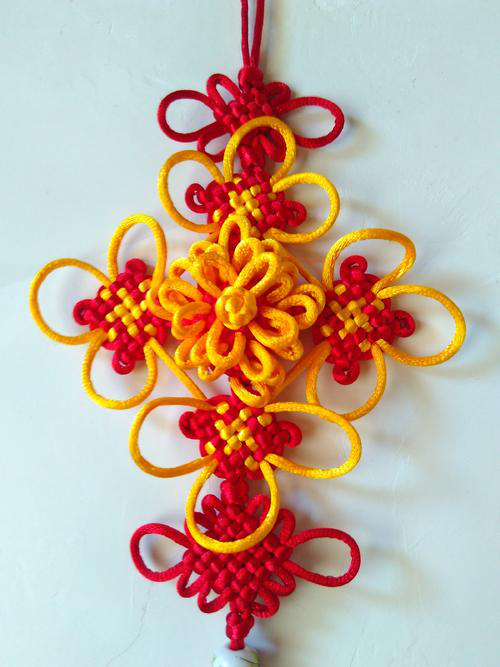
老貓花燈扎制技藝
Laomao Festive Lantern
老貓花燈扎制技藝始于明代。傳統(tǒng)老貓花燈制作題材豐富,花鳥(niǎo)瑞獸造型居多,寓意吉祥。花燈制作時(shí),用竹絲或鐵絲扎制骨架,外糊彩紙或紗絹,或貼剪紙、或施彩繪,造型飽滿(mǎn),鮮艷生動(dòng),制作考究。
The craft of Laomao (literally meaning “old cat”) dated back to the Ming Dynasty (1368-1644). The traditional Laomao festive lanterns cover varied themes, mostly flowers, birds and auspicious animals, which conveys good wishes. To make such a lantern, you need to make a frame with bamboo or iron wire first, before proceeding to cover the frame with colored paper, thin silk, paper-cuts, or paintings. In short, the lanterns are beautifully shaped, featuring bright colors, vivid designs and exquisite appearance.
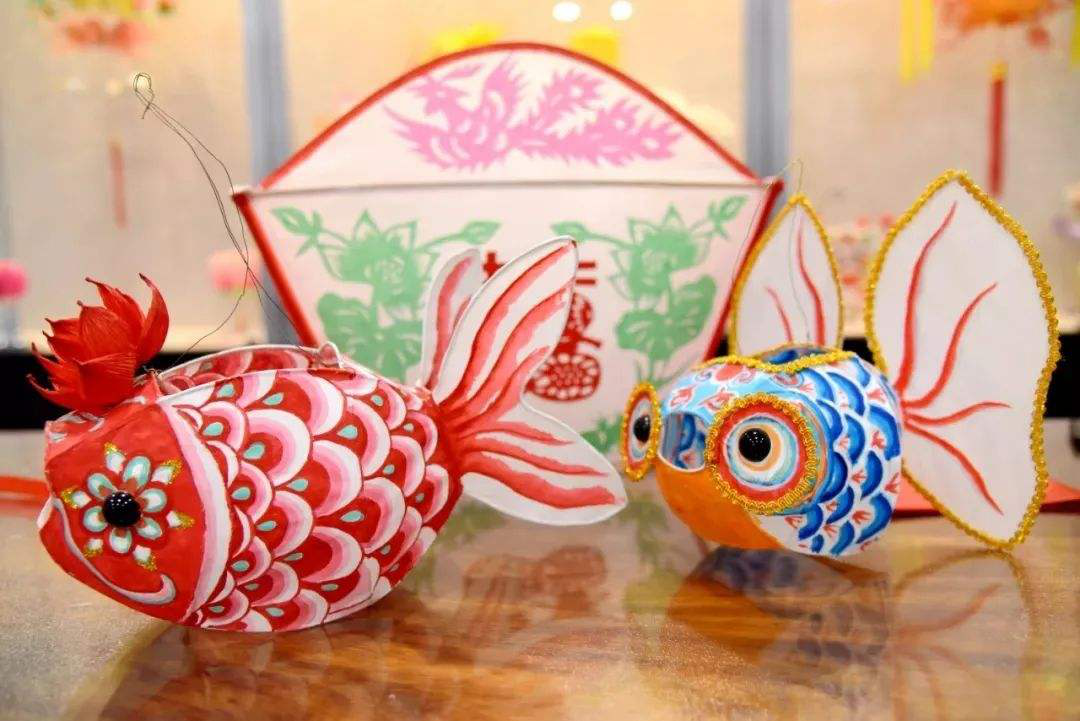
劉氏布偶
Liu Family’s Puppets for Shadow Play
“劉氏布偶”作為一種民間藝術(shù),色彩多為紅、綠、黃、藍(lán)、紫、黑、白、金、銀等對(duì)比強(qiáng)烈的民俗色彩,原料均為無(wú)污染的植物染料,造型采用縫繡、粘貼、手繪、等多種工藝精心制作而成,裝飾多為福、壽等字樣和有吉祥寓意的蝴蝶、金錢(qián)、如意等,融雕塑、剪紙、繪畫(huà)于一體。
Liu Family’s puppets for shadow play, a form of Chinese folk art, features the bright colors that produce a strike contrast, such as red, green, yellow, blue, purple, black, white, gold, and silver colors from pollution-free vegetable dyes. The making of puppets involves multiple elaborate skills, such as sewing, embroidery, pasting, and hand painting. They are usually decorated with the Chinese characters of “fu” (blessings) and “shou” (longevity), or images of butterfly, gold ingot, ruyi (an S-shaped ornamental object), or other auspicious symbols, integrating carving, paper-cutting and painting.

剪影
Silhouette
剪影是運(yùn)用剪刀和黑色紙(或重色紙)剪制人物、動(dòng)物或其它物體外輪廓的剪紙藝術(shù)形式。剪影需要敏銳的觀(guān)察力,豐富的想象力,高度的摹仿力和準(zhǔn)確的判斷力。剪影時(shí),不用臨摹,不用筆畫(huà),抬眼一看,人物的特征就全部記在心里。一剪子下去,眉、眼、鼻、口棱角分明,凹凸起伏渾然天成,線(xiàn)條勻稱(chēng)流暢,僅用二十多秒的時(shí)間即可完成。
Silhouette is a form of paper-cutting art that uses scissors and black paper (or dark-colored paper) to portrait the profile of people, animals or other objects. It requires keen observation, fertile imagination, exceptional ability to imitate, and accurate judgment. To make a silhouette, there is no need for a copy or a painting brush. The artist only needs to have a look at the figure and will have all the features inscribed in his mind. Then, with a pair of scissors and non-stop cut, a silhouette with clearly outlined brows, eyes, nose and mouth will show vividly in front of you. Such a beautifully figured work full of life only takes some 20 seconds to produce.
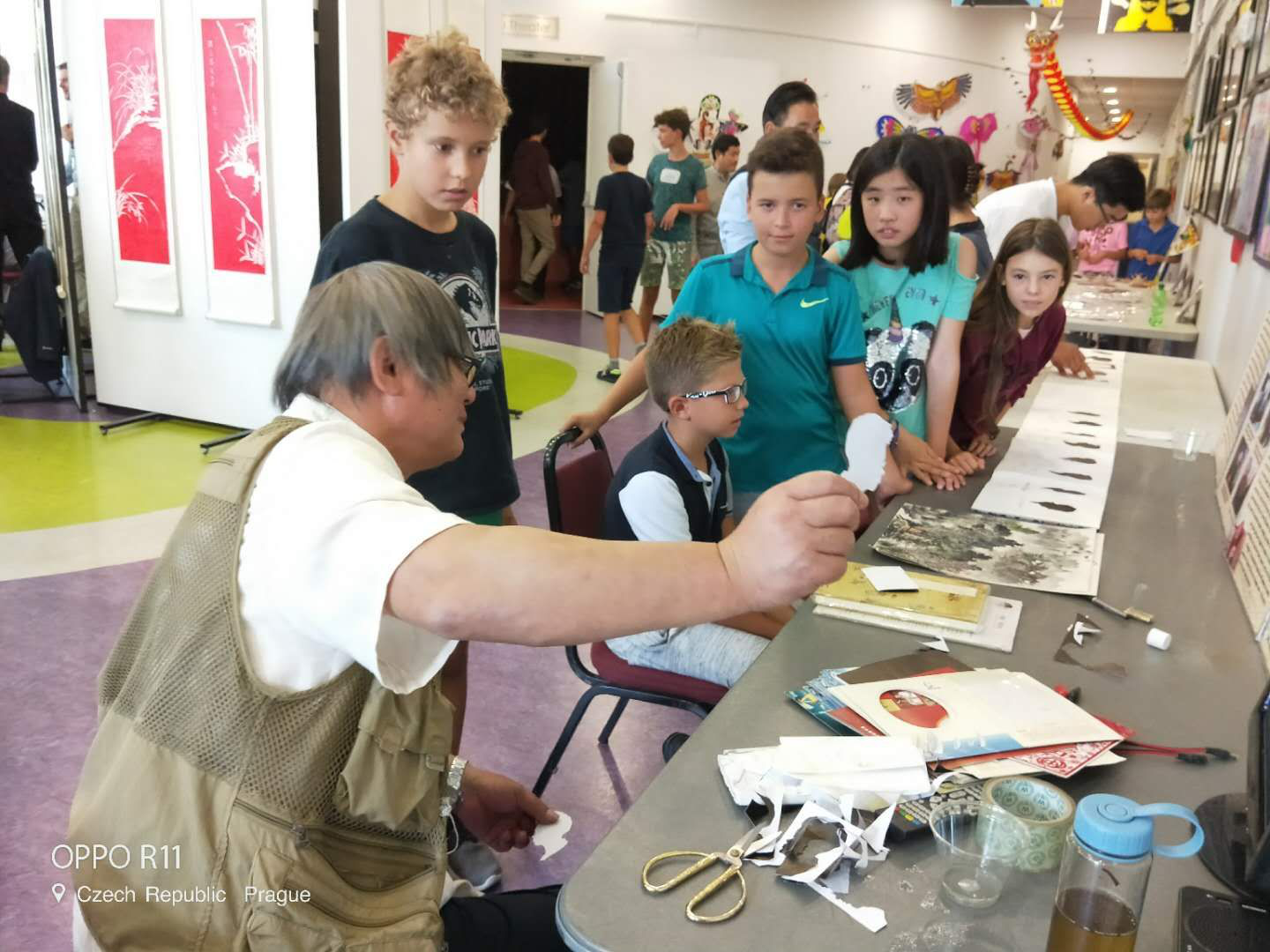
糖畫(huà)
Sugar Painting
糖畫(huà),采用上等冰糖加蜂蜜經(jīng)過(guò)傳統(tǒng)工藝熬制成糖液,再經(jīng)過(guò)繪畫(huà)制成。糖畫(huà)可分為平面糖畫(huà)與立體糖畫(huà)兩種,題材有小說(shuō)、戲曲人物、吉祥花果、飛禽、走獸、文字等,以人物和動(dòng)物的造型最為有趣。糖畫(huà)既可觀(guān)賞,也可食用,深受小朋友及青少年的喜愛(ài),是傳統(tǒng)廟會(huì)、春節(jié)等喜慶節(jié)日的傳統(tǒng)手藝。
Sugar painting is an art to paint with the liquid sugar that is made with traditional techniques from quality crystal sugar and honey. There are two types of sugar paintings: two-dimensional and three-dimensional. The subjects of sugar paintings involve characters from novels or opera plays, auspicious flowers, fruits, birds and animals, or Chinese characters, among which the ones in the images of people and animals are the most amusing. It could be appreciated as an art work or taken as a snack. Most kids and teenagers have been a fan of the sugar painting which is also a traditional craft for festivals like temple fairs and Spring Festival.
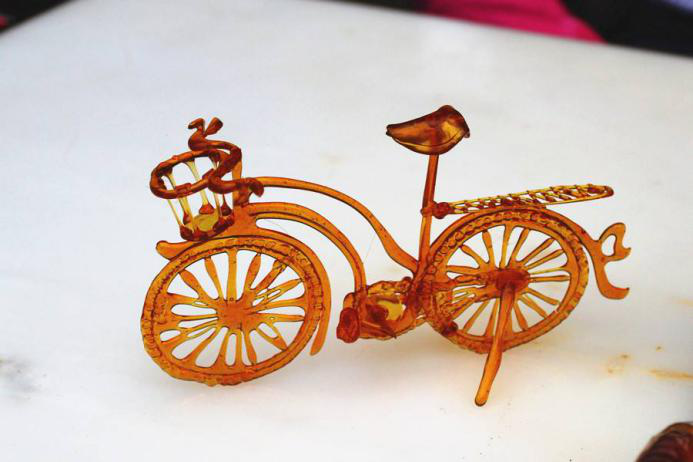
聶家莊泥塑
Niejiazhuang clay sculpture
聶家莊泥塑起源于明萬(wàn)歷年間,至今已有400余年的歷史,本是焰火的附屬品,稱(chēng)為“鍋?zhàn)踊ā薄B櫦仪f泥塑題材寬泛,以泥娃娃、叫虎、叫雞、搖猴等為主,與撲灰年畫(huà)、高密剪紙同稱(chēng)為“高密三絕”。 2008年6月,被國(guó)務(wù)院公布為第二批國(guó)家級(jí)非物質(zhì)文化遺產(chǎn)代表性項(xiàng)目。
The craft of Niejiazhuang clay sculpture emerged during the reign of Emperor Wanli in the Ming Dynasty, with a history of 400-plus years. Originally as an accessory of fireworks, it is dubbed “pot flower”. There is an extensive range of subjects for the figurines, mostly dolls, tiger, chicken, and monkey. Along with ash-patting New Year painting and paper-cut, they were branded the “three most distinguished folk arts in Gaomi”. In June 2008, it was inscribed on the Second Representative List of State-Level Intangible Cultural Heritage in China released by the State Council.
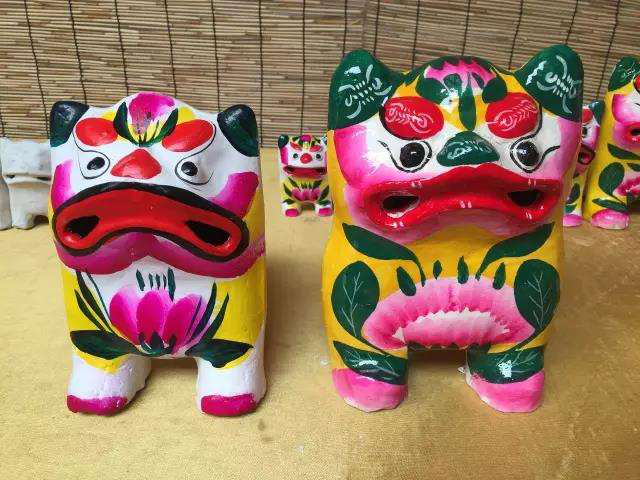
蓬萊小面
Penglai noodles
蓬萊小面系蓬萊傳統(tǒng)名吃,有著近兩百年的歷史。蓬萊小面由多種食材制作而成,用料考究,制作技藝工序繁瑣,形成了量小、面細(xì)、汁鮮的特色。面的制作有和面、溜條、出條三大核心工序,鹵的制作有底湯制作、煮魚(yú)(野生加吉魚(yú))等工序。將煮熟晾涼的面條盛入碗中并澆上鹵汁,蓬萊小面便制作完成了。
Penglai noodle is a traditional local delicacy dating back to almost 200 years. It is made from a variety of ingredients, exquisite materials, and complex procedures. It is characterized by limited ration, slim noodles and delicious soup. The making of noodles goes through three core procedures, namely kneading dough, making dough to strips, and turning strips to noodles. The thick gravy was made after making the soup base, cooking fish (wild snapper) and others procedures. Put the cooled cooked noodles into the bowl and then pour the thick gravy. Then, you can enjoy the Penglai noodle.
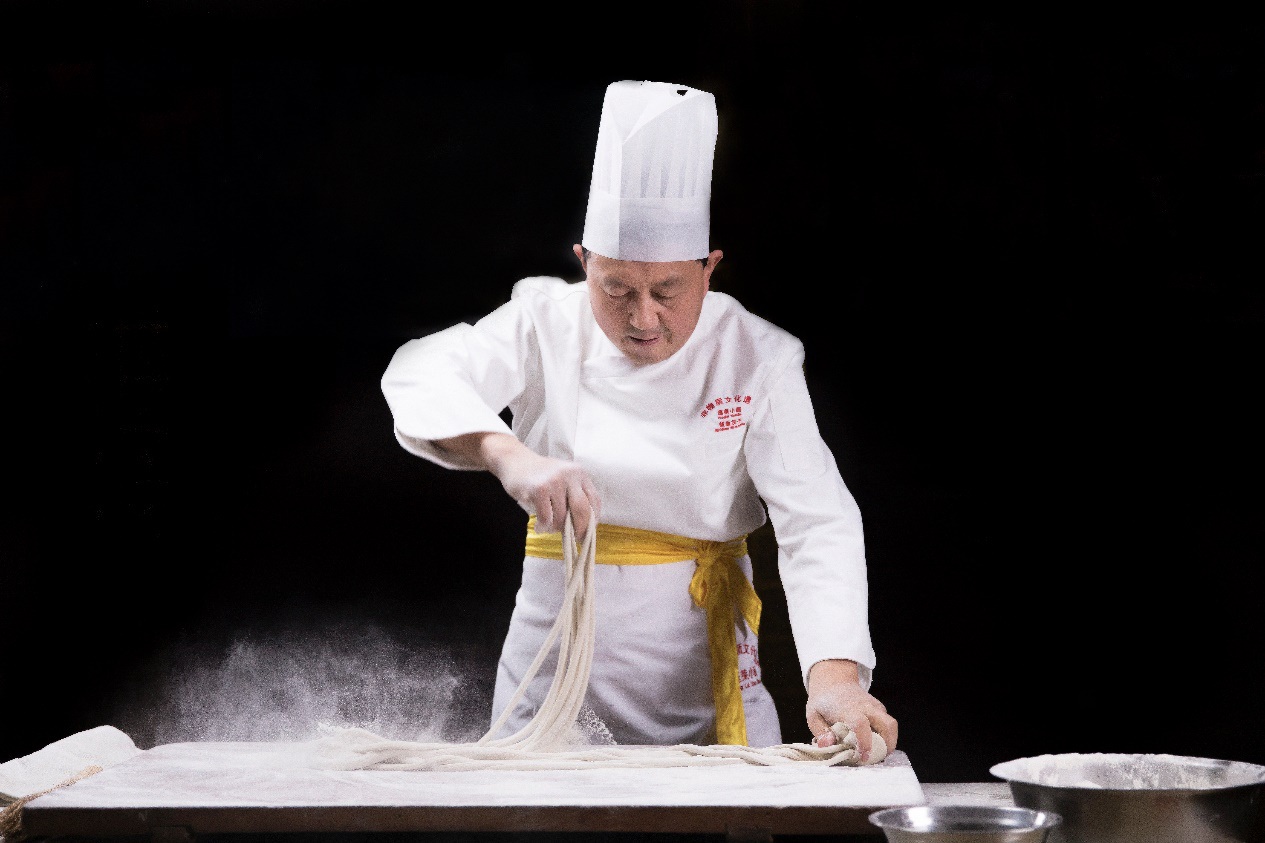
膠東花餑餑
Jiaodong Hua-Bobo
膠東花餑餑以面為加工對(duì)象,以刀、剪、筆等工具進(jìn)行創(chuàng)作,是民間托物寄情、象征豐收喜慶、祈福長(zhǎng)壽、自做自用的生活藝術(shù)用品。膠東花餑餑按其使用功能可分為兩類(lèi):一類(lèi)是專(zhuān)門(mén)用于觀(guān)賞收藏的花餑餑,通常用精面粉、鹽、防腐劑及蜂蜜等制成;另一類(lèi)是可以食用的花餑餑。
Jiaodong Hua-bobo, literally flour flower, refers to flower-shaped steamed buns. It is made from the flour with tools like knife, scissors and pen. It is a folk art of life to convey feelings, celebrate harvest and festivals, pray for longevity, and serve one’s own purpose. In terms of function, Jiaodong Hua-bobo could be divided into two categories. One is for exhibit and collection, usually made from refined flour, salt, preservatives and honey. The other is edible food.
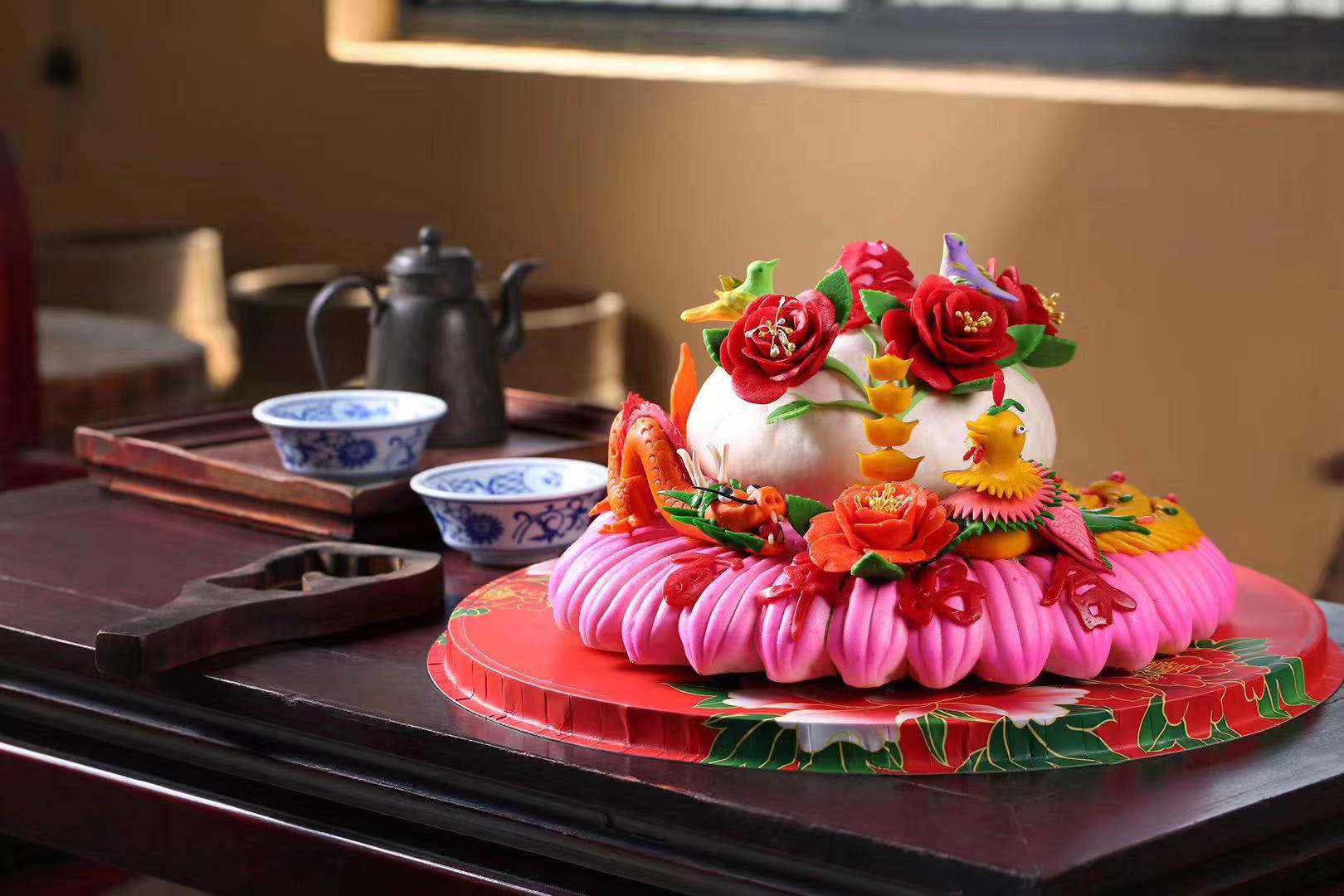
舞獅
Lion Dance
舞獅是中華民族的一門(mén)獨(dú)特藝術(shù),舞獅的表演注重表現(xiàn)獅子的形神兼?zhèn)洌{(diào)動(dòng)現(xiàn)場(chǎng)觀(guān)眾的想象力,其起源可追溯到東漢。東明縣東方舞獅屬于我國(guó)“北獅”藝術(shù)范疇,通常由兩頭獅子或多頭獅子進(jìn)行表演,具有剛勁有力、灑脫奔放、形神兼?zhèn)洹⒐?jié)奏鮮明的藝術(shù)風(fēng)格。
Lion dance is a unique art of the Chinese nation. The key of lion dance is to show both the body and the spirit of the lion and stimulate the imagination of the audience. The art could be traced back to the Eastern Han Dynasty. The Oriental Lion Dance in Dongming County falls under the category of “North Lion Dance”. It is usually performed by two or more “l(fā)ions”, presenting a strong, powerful, free, and distinct style.
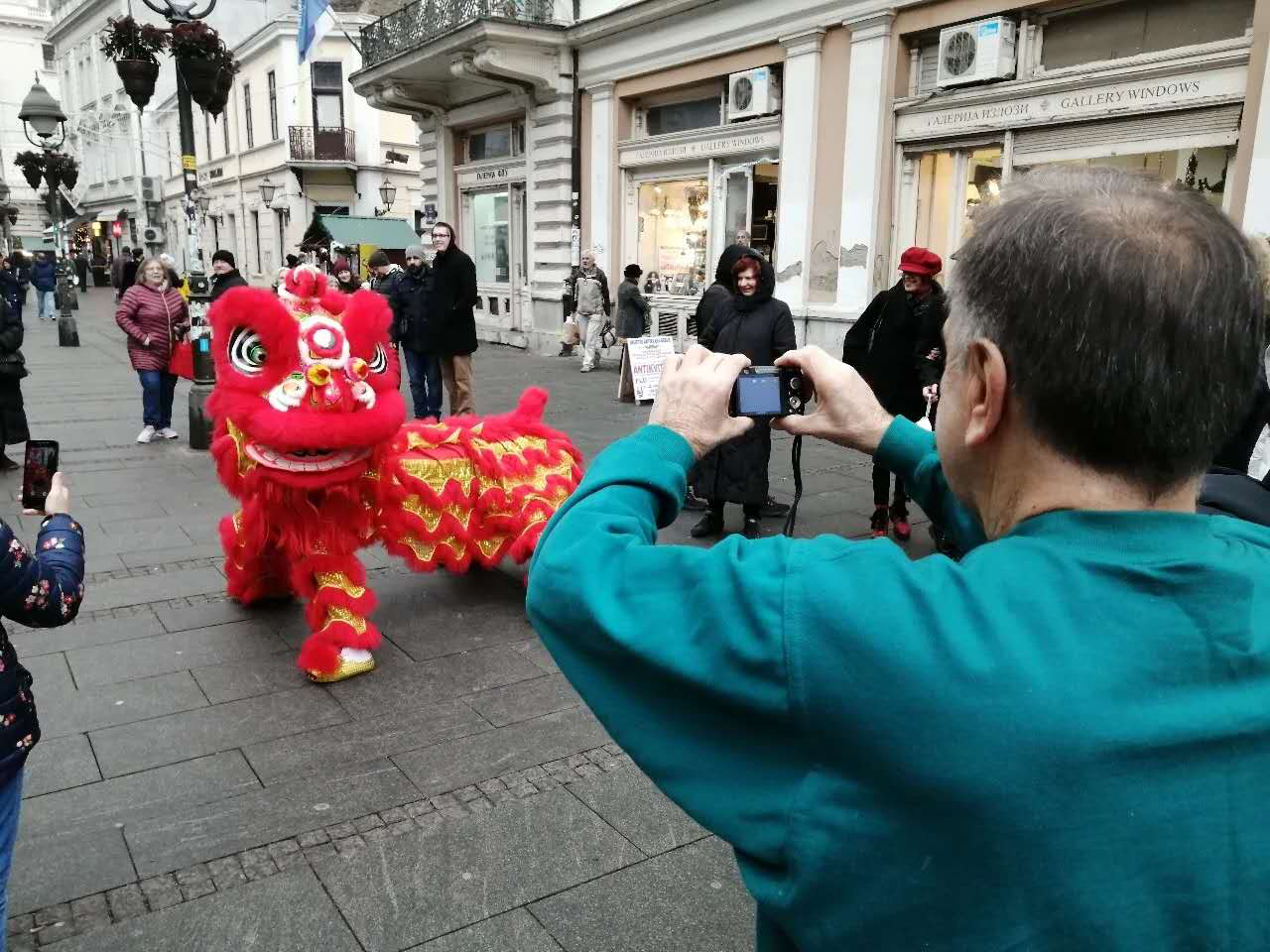
彩印花布傳統(tǒng)印染技藝
Traditional Printing and Dyeing Techniques for Printed Fabric
山東臨沂的彩印花布古樸而濃艷,主要以大紅、翠綠、桃紅、紫、黃等色套印,講求“七紅八綠十二藍(lán)”,民間常以“鵝黃鴨綠雞冠紫,鷺白鴉青鶴頂紅”來(lái)形容其絢麗色彩。彩印花布題材多為牡丹、鳳凰、荷花、富貴、福壽,選題獨(dú)特,構(gòu)圖飽滿(mǎn),色彩艷麗,對(duì)比強(qiáng)烈,質(zhì)樸豪放。
The printed fabric in Linyi of Shandong Province is of primitive simplicity and bright-colored, mainly in red, emerald green, pink, purple, yellow, among others. There are seven types of red color, eight types of green color and twelve types of blue color. The local people usually describe the brilliant colors as goose yellow (light yellow), duck green, cockscomb purple, egret white, crow cyan, and crane-heading red. The printed fabric largely features peony, phoenix, lotus, and others that carry the implications of prosperity and longevity. The printed fabric is unique, lively, bright-colored, and primitively simple.

濰坊風(fēng)箏制作技藝
Weifang Kite Craft
濰坊風(fēng)箏興于明初的楊家埠村。那時(shí),村民以木版年畫(huà)的刻印技術(shù),用印年畫(huà)的紙張、顏料,繪制出各種圖案,扎制風(fēng)箏。其扎制方法雖簡(jiǎn)單,少則竹條三根,多不超過(guò)七根,但講究竹條均勻、骨架周正、左右對(duì)稱(chēng)、重心拴線(xiàn),形象簡(jiǎn)練,色彩鮮艷,對(duì)比強(qiáng)烈。濰坊風(fēng)箏具有起飛平穩(wěn)、放飛高的特征。
Weifang kite was born in Yangjiabu Village in the early Ming Dynasty. At that time, the villagers made kites by applying the engraving technique for woodcut New Year paintings and drawing various patterns with the paper and dyestuff for the New Year paintings. It is easy to make the frame of the kite, requiring three to seven bamboo strips. The key is that the strips must be evenly shaped, so that the frame could be upright and symmetrical. Then, tie a string to the center of the frame. The kite looks simple and rich-colored, producing a striking contrast. Weifang kites are known for smooth takeoff and flying high.
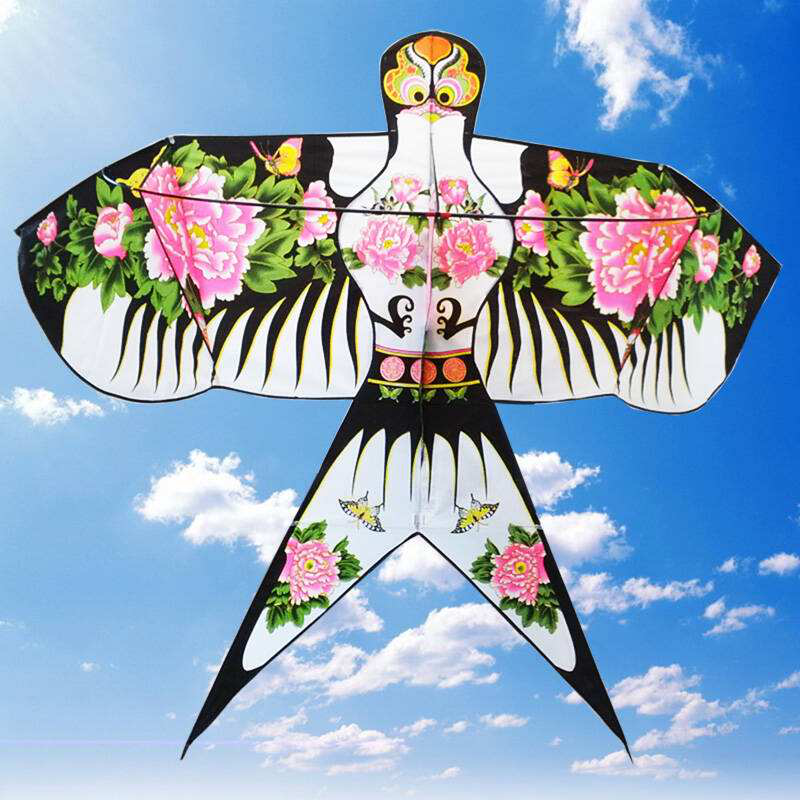
煙臺(tái)剪紙
Yantai Paper-cut
煙臺(tái)剪紙包括單色剪紙、勾繪染色剪紙、拼色剪紙、襯色剪紙等,特點(diǎn)是剪得干凈利索,形象優(yōu)美生動(dòng),講究虛實(shí)對(duì)比,并擅長(zhǎng)用篦紋來(lái)增加色彩的濃淡層次。從傳世的明代道教音樂(lè)剪紙,戚繼光練兵的“盾牌舞”、“小刀舞”和明代中期表現(xiàn)南音演奏的剪紙來(lái)看,煙臺(tái)剪紙有著悠久的歷史,在中國(guó)的剪紙藝術(shù)中獨(dú)具特色,久負(fù)盛名,具有深厚的歷史價(jià)值和實(shí)用價(jià)值。
Yantai paper-cut features the use of single-color paper, painted and dyed paper, paper of mixed colors, and the colored paper beneath single-color paper. Yantai paper-cut is characterized by clear outline, vivid images, striking contrast, and the outstanding use of exquisite lines to enrich the layers of the colors. Judging from the famous paper-cuts about music in Taoism in the Ming Dynasty, the “Shield Dance” and “Sword Dance” in the drill ground of General Qi Jiguang, and the Nanyin Music (southern music) in the mid-Ming Dynasty, Yantai paper-cut has a long history. As a unique genre of Chinese paper-cutting art, this prestigious art has been of profound significance in history and practice.
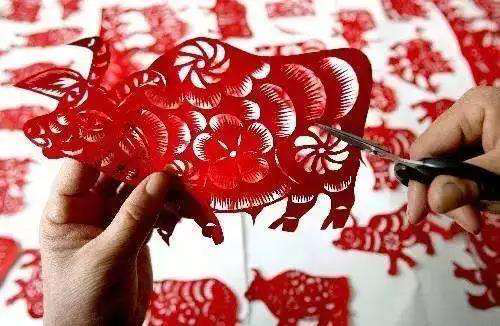
濱州民間剪紙
Binzhou Paper-cut
濱州民間剪紙廣泛分布于黃河、徒駭河流域的廣大鄉(xiāng)村集鎮(zhèn),有著濃郁的地方特色和鄉(xiāng)土氣息,題材非常廣泛,有戲曲人物、神話(huà)故事及鳥(niǎo)、獸、蟲(chóng)、魚(yú)等。它還有不少直接反映勞動(dòng)人民生活和當(dāng)?shù)孛袼谆顒?dòng)的題材。濱州民間剪紙外輪廓粗獷,內(nèi)部裝飾簡(jiǎn)潔,整體感強(qiáng)。
Binzhou paper-cut is widely distributed in the vast rural market towns along the Yellow River and Tuhai River basins. It features rich local characteristics and rustic flavors, covering a wide range of themes, such as opera characters, mythological stories, birds, beasts, insects, and fish. Sometimes, it also gives a glimpse into the lives of working people and local folklore activities. Binzhou paper-cut is known for its rough outlines, simple and clear interiors, giving a sense of wholeness.
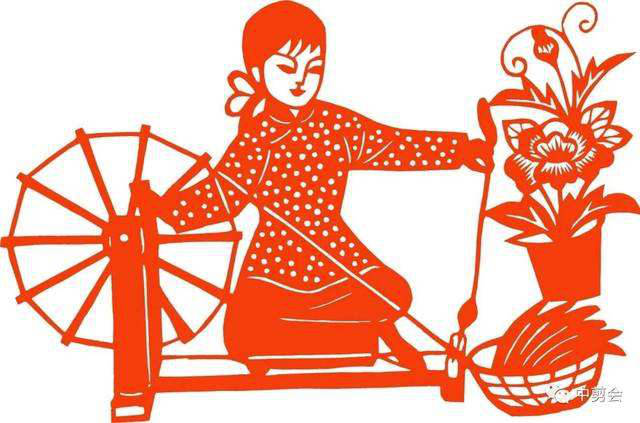
濟(jì)南皮影戲
Ji’nan Shadow Play
濟(jì)南皮影戲是中國(guó)皮影的一個(gè)分支,它的表演形式主要是一人操作、說(shuō)唱,一人伴奏。過(guò)去的影人很小只有20厘米,后經(jīng)過(guò)改良,增至50厘米甚至1米多,并加上了色彩。開(kāi)始的影幕也很小,后改為2米高4米寬。唱腔吸收了五音戲、西河大鼓、山東琴書(shū)等戲曲唱腔,自然流暢、聲情并茂。皮影藝人身懷絕技,一人同時(shí)操縱數(shù)個(gè)影偶,可即興演唱,真假聲轉(zhuǎn)換,演奏不同樂(lè)器。
Ji’nan shadow play is a branch of Chinese shadow play. It involves two performers, one rapper who also controls the puppet characters, and the other is for accompaniment. In the past, the leather puppet was merely 20cm in height. Over time, it is increased to 50cm or even one meter, and it began to have colors. The small screen has also been expanded to the size of 2 meters high and 4 meters wide. The shadow show gradually absorbed the tunes of operas like Wuyin Opera, Xihe Dagu (a folk art form in Hebei), Shandong Qinshu and others, producing a pleasant sound. The shadow players possess remarkable skills to control multiple puppets simultaneously, give impromptu performance, switch between voice and falsetto, and play different instruments.
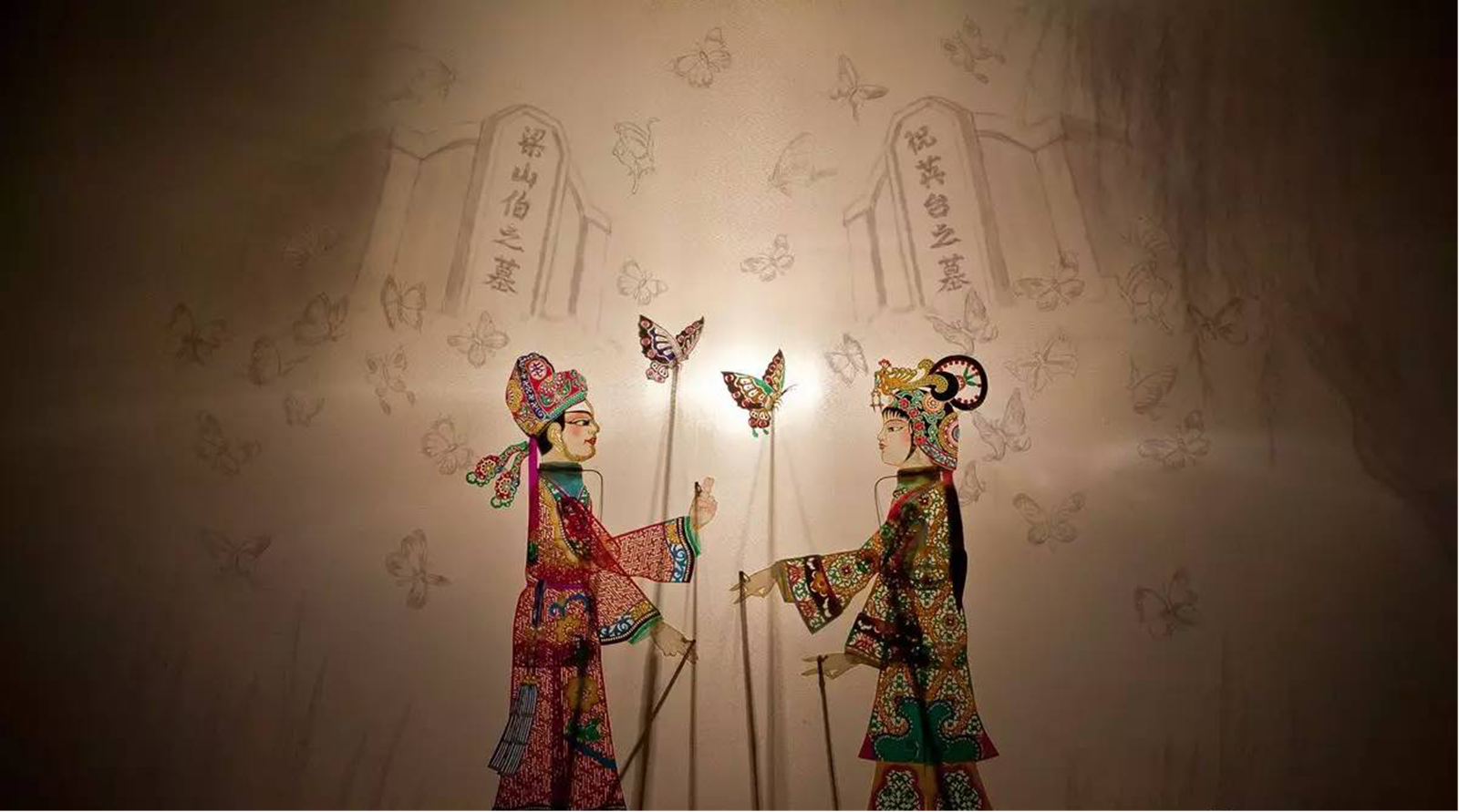
泰山皮影戲
Mount Taishan Shadow Play
泰山皮影戲是泰山文化的重要組成部分,人物形象往往取材于泰山民間剪紙和傳統(tǒng)戲曲臉譜。皮影人物的行當(dāng)基本與戲曲行當(dāng)相同,影人的高低約在50公分左右,具有豐富而獨(dú)特的唱腔體系。泰山皮影戲的劇目非常豐富,尤以《泰山石敢當(dāng)》系列劇最為著名。泰山皮影戲演出無(wú)劇本,完全靠演員的記憶,屬典型的口傳民間文化內(nèi)容。
Mount Taishan shadow play constitutes an integral part of Taishan culture. The characters are often based on the Taishan folk paper-cuts and traditional opera facial makeup. The types of roles for puppets are basically the same with that in opera. The puppets are about 50cm high. The shadow play boasts a rich and unique tune system. The repertoire of Taishan shadow play is extensive, among which the series of Taishan Shi-Gan-Dang is the most famous. Mount Taishan Shadow Play has no script and the performers must remember the stories that are passed down from generation to generation orally.
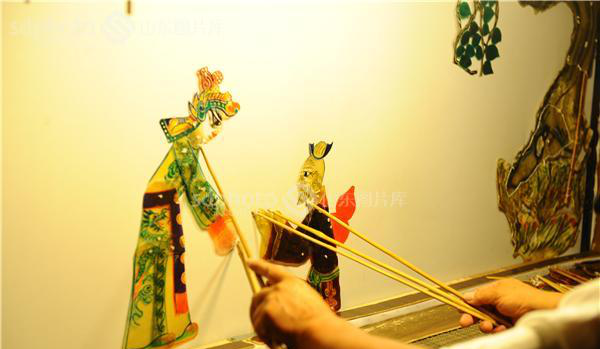
親愛(ài)的朋友們!2020年中國(guó)山東省要在全球招募2萬(wàn)名“孔子旅游使者”,歡迎大家一起來(lái)了解“孔子家鄉(xiāng)·好客山東”。
Dear friends, Shandong is to recruit 20,000 “Confucius Tourism Representatives” from all around the world. Join us to know about “Friendly Shandong, the home of Confucius”.
山東是一個(gè)文明現(xiàn)代、山川壯麗、歷史悠久、人文薈萃的地方,位于中國(guó)東部沿海、黃河下游,與韓國(guó)、日本隔海相望,地處“一帶一路”東端交匯點(diǎn),曾誕生過(guò)孔子、孟子、曾子、子思以及墨子、孫子等一批中國(guó)思想文化巨人,GDP位居中國(guó)第三,人口超過(guò)1億。
Shandong boasts modern civilization, magnificent mountains and rivers, time-honored history and a galaxy of talents. It is located on the eastern coast of China, at the lower reaches of the Yellow River, across the sea from South Korea and Japan, and at the juncture of the eastern section of “Belt and Road”. It’s the birthplace of a group of thinkers and contributors to Chinese culture, such as Confucius, Mencius, Zengzi, Zisi, Mozi, and Sunzi. Shandong has the third highest GDP in China, with a population of over 100 million.
我們期待在“孔子家鄉(xiāng)·好客山東”與你相遇!
We look forward to meeting you in Shandong.
掃描文末二維碼關(guān)注“孔子旅游使者”官方微信公眾號(hào),及時(shí)了解更多活動(dòng)信息!
To keep updated about the event, please scan the QR code below to follow the official WeChat account of “Confucius Tourism Representative”.
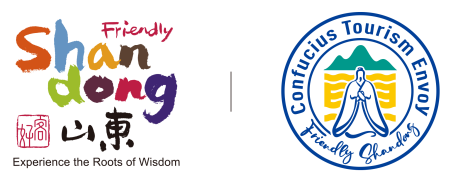
山東省文化和旅游廳
點(diǎn)擊關(guān)注孔子旅游使者微信公眾號(hào)
獲取最新活動(dòng)相關(guān)信息
Click here to follow the official WeChat account of Confucius Tourism Representative to keep updated about the event.





